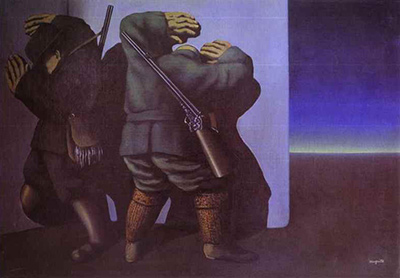The Hunters at the Edge of Night is a 1928 oil on canvas painting by Rene Magritte. Magritte was a Belgian artist who lived from 1898 to 1967 and is works (which primarily consist of oil on canvas paintings like this one) fall firmly into the category of Surrealism.
The Hunters at the Edge of Night was painted towards the end of what are known as Magritte's 'Paris Years'. This epoch began in the early 1920s and it was a time when Magritte was learning about Surrealism, writing his own articles on Surrealism and experimenting with the colourful, off kilter depiction of seemingly ordinary objects that was to earn him the title of one of the most famous Surrealist painters in the world.
The Hunters at the Edge of Night depicts two men who, from the style of their clothing and the fact that they are both carrying rifles, are clearly the eponymous hunters of the painting's title. The painting's title also sees that we see these hunters 'at the edge of night', and this is where the Surrealist element of the painting comes in.
It seems that morning is depicted as a solid, pale metallic blue wall that sections the two hunters off. The solidity of the dawn is hyper-real and yet it also evokes the sense of dawn hitting the hunters' faces suddenly in a manner that is realistic. The hunters' garb is painted with detailed brushstrokes, and this type of realistic depiction is characteristic of Magritte's work. Their dramatic reactions to the dawn emphaise the drama of the piece.
The Hunters at the Edge of Night also deploys a stark, bare landscape as a significant part of the painting. This is something that he incorporates into many of his art works (Oasis and Memory of a Voyage are just two examples), and it may even be said to be one of the trademark features of his work.




